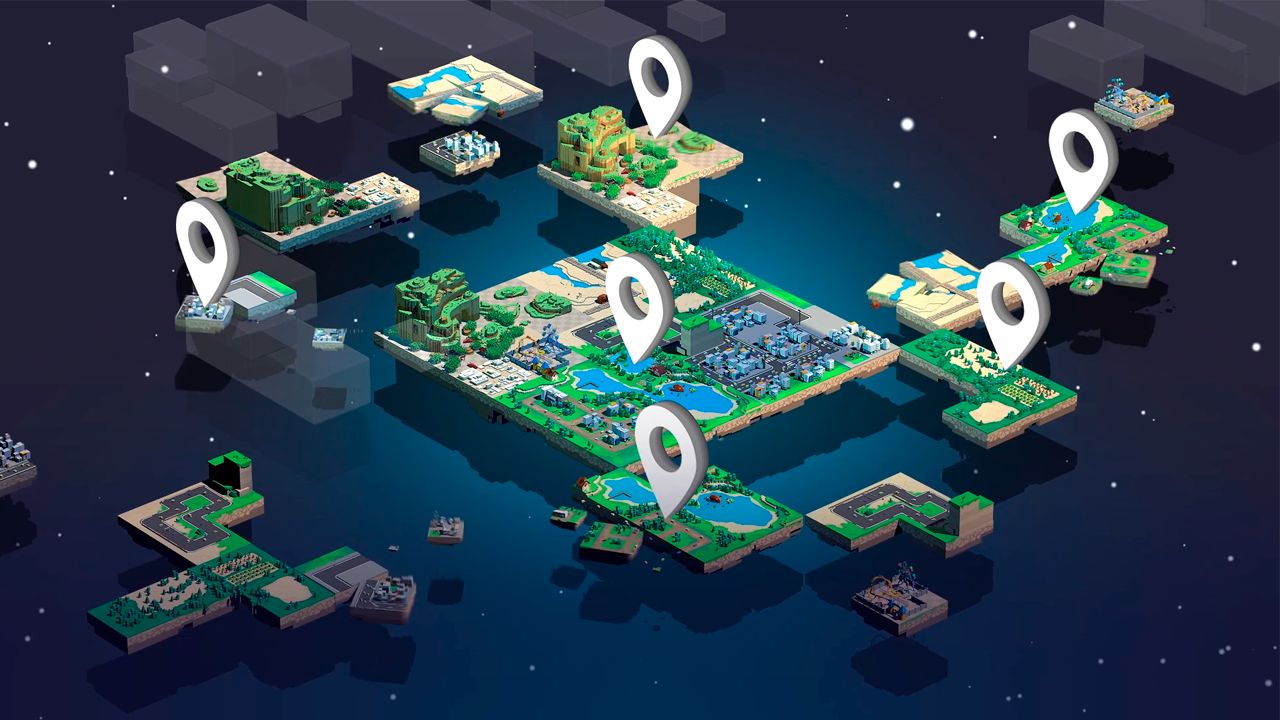Introduction
The concept of the metaverse has garnered immense attention in recent years, captivating the imagination of both businesses and consumers alike. As a virtual reality environment where users can interact with each other and digital content, the metaverse offers vast opportunities for advertising and brand promotion. This article will delve into the world of metaverse advertising and provide insights on how businesses can effectively leverage this emerging platform to reach their target audience.
With the growing popularity of virtual reality, augmented reality, and immersive technologies, the metaverse represents a new frontier for brand exposure and engagement. It is no longer limited to sci-fi movies or gaming communities; the metaverse is rapidly becoming a part of our daily lives.
As businesses strive to stay ahead of the competition and connect with consumers in new and innovative ways, embracing metaverse advertising becomes crucial. By immersing users in a virtual environment, advertising in the metaverse adds an interactive and immersive dimension to the traditional marketing landscape.
However, it is important to note that metaverse advertising is not just about bombarding users with promotional messages. It requires careful planning, strategic targeting, and creating engaging content that resonates with the metaverse community. This article will guide you through the various aspects of metaverse advertising and equip you with the knowledge to make informed decisions about your advertising campaigns.
Throughout this article, you will explore topics such as understanding the metaverse, targeting your audience in the metaverse, choosing the right platforms for advertising, creating engaging content, leveraging influencers and creators, measuring campaign success, ensuring brand safety, and future trends and innovations.
Whether you are a small business or a multinational corporation, the metaverse offers exciting possibilities to connect with your target audience in ways that were previously unimaginable. By exploring the realm of metaverse advertising, you can establish a strong brand presence, engage with consumers on a deeper level, and ultimately drive business growth. So, let’s dive into the world of the metaverse and uncover the potential it holds for your advertising endeavors.
Understanding the Metaverse
The metaverse is a virtual reality environment where users can interact with each other and digital content in a three-dimensional space. It is a collective virtual shared space that encompasses various virtual and augmented reality platforms, social networks, gaming communities, and virtual worlds. In the metaverse, users can create avatars, explore virtual environments, attend events, participate in games and activities, and connect with others from all around the world.
Unlike traditional online platforms, the metaverse emphasizes immersion and interactivity. It blurs the boundaries between the physical and digital worlds, offering a seamless fusion of real-life experiences and virtual content. Users can engage in various activities, from socializing and shopping to attending virtual conferences or concerts.
The metaverse is built on advanced technologies such as virtual reality (VR), augmented reality (AR), blockchain, and artificial intelligence (AI). These technologies enable the creation of realistic and immersive virtual environments that simulate real-world interactions. With the continuous advancements and adoption of these technologies, the metaverse is evolving into a robust ecosystem with limitless potential.
The metaverse offers significant opportunities for businesses and advertisers to connect with consumers in innovative ways. It allows brands to create virtual storefronts, host virtual events, showcase products, and engage with customers through immersive experiences. By tapping into the metaverse, businesses can reach a new audience, boost brand awareness, and drive customer loyalty.
However, it is important to understand that the metaverse is not a singular platform or entity. Rather, it is a collection of interconnected platforms and virtual spaces. From virtual worlds like Second Life and Decentraland to social media platforms like Facebook’s Horizon Workrooms, each platform within the metaverse has its own unique features and user base.
As a marketer or advertiser, it is crucial to have a comprehensive understanding of the different platforms within the metaverse and the demographics of their users. This knowledge will enable you to choose the right platforms for your advertising campaigns and tailor your messaging to resonate with the target audience.
Furthermore, it is essential to stay updated on the latest trends and developments in the metaverse landscape. The metaverse is a dynamic and rapidly evolving space, with new platforms and technologies emerging regularly. By keeping a pulse on the metaverse ecosystem, you can adapt your advertising strategies to align with the evolving consumer preferences and technological advancements.
In the next section, we will explore how you can effectively target your audience within the vast metaverse landscape. Understanding the demographics and preferences of metaverse users will help you create targeted and impactful advertising campaigns.
Targeting Your Audience in the Metaverse
When it comes to advertising in the metaverse, one of the key factors for success is effectively targeting your audience. With the diverse range of platforms and virtual communities within the metaverse, it is important to understand the demographics and preferences of your target audience.
One way to target your audience in the metaverse is by considering the platform or virtual world where you want to advertise. Each platform attracts a specific user base, whether it’s a gaming community, a social virtual reality platform, or a virtual marketplace. Research and analyze the platforms to understand their user demographics, interests, and behaviors. This information will help you identify the platforms that align with your target audience and ensure that your advertising efforts are reaching the right people.
Another important aspect of targeting your audience in the metaverse is considering the interests and preferences of your target demographic within the virtual space. For example, if your target audience consists of gamers, you can explore advertising within popular gaming communities or virtual reality games. If your brand aligns with fashion or lifestyle, you might consider advertising within virtual marketplaces where users can purchase and customize virtual clothing or accessories.
Engaging with the metaverse community and understanding their needs and desires is vital for effective audience targeting. Participate in virtual events, join relevant groups, and interact with users to gain insights into their interests and preferences. This will enable you to craft advertising messages that resonate with your target audience and create meaningful connections.
Utilizing user data and analytics is another valuable method for targeting your audience in the metaverse. Many virtual platforms provide analytics tools that allow you to gather data on user behavior, engagement, and demographics. By analyzing this data, you can identify patterns, refine your target audience, and optimize your advertising campaigns for better results. Use this information to tailor your content, messaging, and advertising strategies to meet the specific needs and desires of your audience.
In addition to these methods, leveraging influencers and creators within the metaverse can greatly enhance your audience targeting efforts. Influencers and creators have established followings and influence within the metaverse community. Collaborating with them can help you connect with their audience and tap into their credibility and influence to promote your brand or products. Choose influencers and creators whose values align with your brand, and work with them to create authentic and engaging content that resonates with their followers.
In the next section, we will explore how to choose the right platforms for advertising in the metaverse. Understanding the strengths and unique features of different platforms will allow you to make informed decisions and maximize the impact of your advertising campaigns.
Choosing the Right Platforms for Advertising
When it comes to advertising in the metaverse, choosing the right platforms is crucial for reaching your target audience and maximizing the impact of your campaigns. With a plethora of virtual reality platforms, social networks, and gaming communities available, it can be overwhelming to determine where to allocate your advertising efforts. Here are some factors to consider when choosing the right platforms for metaverse advertising.
1. Understanding your target audience: Start by understanding the demographics, interests, and behaviors of your target audience. This will help you identify the platforms or virtual worlds that align with your target market. For example, if you are targeting gamers, platforms like Fortnite or Roblox may be ideal. If you are targeting professionals, platforms like Facebook’s Horizon Workrooms or virtual conference platforms would be more suitable.
2. Platform popularity and user base: Consider the popularity and user base of the platforms you are considering for advertising. Look for platforms with a large and engaged user base that aligns with your target audience. Platforms with a vibrant and active community will likely yield better results for your advertising campaigns.
3. Platform features and capabilities: Evaluate the features and capabilities of the platforms. Do they offer advertising opportunities within the virtual environment? Can you create immersive experiences or interactive ad formats? Look for platforms that provide the tools and functionalities that align with your advertising goals and enable you to deliver engaging content to your audience.
4. Integration with other platforms: Consider how the platform integrates with other virtual reality platforms, social networks, or e-commerce platforms. Integration can provide you with additional opportunities to extend your reach and amplify your advertising efforts. For example, if a platform allows users to seamlessly share their experiences on social media, it can increase the visibility and exposure of your brand beyond the metaverse.
5. Ad targeting capabilities: Assess the platform’s ad targeting capabilities. Look for platforms that provide robust targeting options, allowing you to reach your desired audience based on demographics, interests, or behavior. The ability to target specific audience segments will ensure that your advertising message reaches the right people in the metaverse.
6. Budget and ROI: Consider your budget and evaluate the potential return on investment (ROI) of advertising on a particular platform. Determine if the platform’s pricing aligns with your budget, and assess the potential reach and engagement you can achieve. It’s important to strike a balance between cost and the potential impact of your advertising campaigns.
Remember, not all platforms may be relevant for your specific advertising goals and target audience. It’s important to prioritize the platforms that align with your objectives and have the potential to deliver the highest impact. By selecting the right platforms for advertising in the metaverse, you can effectively reach your target audience, drive brand awareness, and generate meaningful engagement.
In the next section, we will discuss how to create engaging content for the metaverse. Crafting compelling and immersive experiences will help you capture the attention and interest of your audience in the virtual environment.
Creating Engaging Content for the Metaverse
In the metaverse, where users are immersed in a virtual reality environment, creating engaging content is essential to capture their attention and leave a lasting impression. To effectively advertise in the metaverse, you need to craft compelling experiences that resonate with your audience and leverage the unique characteristics of this virtual space.
Here are some tips for creating engaging content for the metaverse:
1. Embrace interactivity: The metaverse is all about interaction and immersion. Incorporate interactive elements into your content to encourage user engagement. This could include interactive ads, virtual product demonstrations, or gamified experiences. By allowing users to actively participate, you create a more engaging and memorable experience.
2. Tell a story: Stories have a powerful impact on human emotions and can create a deeper connection with your audience. Use storytelling techniques to communicate your brand message and values within the metaverse. Develop narratives that resonate with users and make them feel a part of the story. This can be done through virtual experiences, narratives within games, or virtual events that unfold over time.
3. Utilize immersive technologies: Take advantage of the immersive technologies available in the metaverse, such as virtual reality (VR) or augmented reality (AR). Immersive experiences can transport users to new worlds, simulate real-life scenarios, or provide a unique perspective. By incorporating these technologies, you can create an immersive and memorable experience that sets your brand apart.
4. Collaborate with creators and influencers: Partnering with creators and influencers in the metaverse can help amplify your content and tap into their established audience. Work with influential personalities or content creators whose values align with your brand to create engaging content together. Their influence and expertise in the metaverse can add credibility and reach to your advertising efforts.
5. Personalize the experience: Customization and personalization are highly valued in the metaverse. Tailor your content to individual users by offering personalized product recommendations, avatar customization options, or unique virtual experiences. By providing a personalized experience, you create a sense of exclusivity and make users feel more connected to your brand.
6. Encourage user-generated content: Leverage the power of user-generated content (UGC) to enhance engagement and create a sense of community. Encourage users to share their experiences with your brand in the metaverse by providing incentives or hosting UGC contests. This not only generates buzz around your brand but also fosters authenticity and user involvement.
7. Stay updated on trends: The metaverse is constantly evolving, with new trends and technologies emerging regularly. Stay updated on the latest advancements in the metaverse to ensure your content remains relevant and aligns with current user preferences. Incorporating popular trends and innovative technologies can help you stand out and capture the attention of your audience.
By creating engaging content for the metaverse, you can captivate your audience and build a strong brand presence in this virtual space. Remember to constantly experiment, iterate, and listen to user feedback to refine and optimize your content strategy in the dynamic metaverse environment.
Next, we will explore how leveraging influencers and creators in the metaverse can amplify your advertising efforts and drive greater brand exposure.
Leveraging Influencers and Creators in the Metaverse
Influencers and creators play a significant role in shaping the metaverse community, and partnering with them can greatly amplify your brand’s presence and reach within this virtual environment. Leveraging influencers and creators in the metaverse allows you to tap into their established following, credibility, and influence to promote your brand or products. Here’s how you can effectively leverage influencers and creators for your metaverse advertising campaigns:
1. Identify relevant influencers and creators: Start by identifying influencers and creators whose values, content, and audience align with your brand. Look for individuals who have a substantial following and engagement within the metaverse community. Research their content, engagement metrics, and audience demographics to ensure that they are a good fit for your brand’s objectives.
2. Foster authentic collaborations: Successful influencer and creator partnerships in the metaverse rely on authenticity and genuine collaboration. Work closely with influencers and creators to develop custom experiences, content, or virtual events that align with your brand and resonate with their audience. Allow them the creative freedom to express themselves while incorporating your brand seamlessly into the content.
3. Showcase your brand through their experiences: Influencers and creators in the metaverse have a unique ability to provide firsthand experiences and insights to their followers. Collaborate with them to showcase your brand through their virtual adventures, events, or gameplay sessions. This allows their audience to experience your brand in an authentic and immersive way, increasing brand awareness and interest.
4. Encourage user engagement and participation: One of the strengths of influencers and creators is their ability to drive user engagement. Encourage their followers to engage with your brand by incorporating interactive elements, challenges, or giveaways. This generates buzz, creates a sense of community, and boosts the overall impact of your metaverse advertising campaigns.
5. Use affiliate marketing and referral programs: Consider implementing affiliate marketing or referral programs with influencers and creators in the metaverse. Provide them with unique tracking links or codes that their audience can use to make purchases or access exclusive content. By incentivizing their followers to take action, you can drive conversions and measure the effectiveness of your influencer partnerships.
6. Amplify content through cross-promotion: Collaborate with influencers and creators to cross-promote each other’s content within the metaverse and other social platforms. This expands your reach beyond their audience and exposes your brand to new virtual communities. Cross-promotion can take the form of shoutouts, guest appearances, or collaborations on virtual events or campaigns.
7. Measure and analyze performance: As with any advertising campaign, it is crucial to measure the performance of your influencer and creator partnerships. Track key metrics such as reach, engagement, conversions, or sentiment analysis to evaluate the impact of your collaborations. This data will help you fine-tune your strategies and identify which influencers or creators are most effective for your brand’s objectives.
By leveraging influencers and creators in the metaverse, you can tap into their influence and reach while building authentic connections with the metaverse community. These collaborations provide an opportunity to showcase your brand and products within the virtual environment, driving brand awareness, engagement, and ultimately, business growth.
Next, we will explore how to measure the success of metaverse advertising campaigns, allowing you to gain insights and optimize your strategies for better results.
Measuring the Success of Metaverse Advertising Campaigns
Measuring the success of your metaverse advertising campaigns is crucial for understanding the effectiveness of your strategies and making data-driven decisions for future campaigns. While traditional metrics like reach and engagement still hold importance, there are specific considerations when it comes to measuring the success within the metaverse. Here are key metrics and strategies to consider:
1. Reach and engagement: Track the reach and engagement of your metaverse advertising campaigns. Measure the number of impressions, views, or interactions your ads receive. Additionally, monitor engagement metrics such as likes, comments, shares, or virtual world interactions. These metrics provide insights into the initial impact and audience interaction with your campaigns.
2. Conversion tracking: Implement conversion tracking to measure the effectiveness of your metaverse advertising in generating desired actions. Whether it’s driving users to visit your website, make a purchase, or download an app, tracking conversions allows you to understand the direct impact of your campaigns on driving actual results.
3. User feedback and sentiment analysis: Listen to user feedback and conduct sentiment analysis to understand how users perceive your brand and advertising within the metaverse. Monitor comments, reviews, or virtual world discussions to gauge the sentiment towards your campaigns. This qualitative data provides valuable insights into the user experience and sentiment surrounding your brand.
4. Virtual world analytics: Many virtual worlds and metaverse platforms provide analytics tools to track user behavior and interactions within their virtual environments. Utilize these tools to gain insights into user behavior, the popularity of virtual spaces where your campaigns are displayed, or the level of user engagement with your brand assets. This data helps you identify the most effective areas within the metaverse for your advertising efforts.
5. Collaborator and influencer impact: Evaluate the impact of your collaborations with influencers and creators within the metaverse. Track metrics such as referral traffic, conversions attributed to influencer partnerships, or the engagement generated by influencer-generated content. Assess the qualitative impact as well by considering feedback from influencers, creators, and their audience regarding the perception and effectiveness of your metaverse advertising campaigns.
6. Comparative analysis: Conduct comparative analysis by comparing the performance of different metaverse platforms, virtual world spaces, or influencer collaborations. This allows you to identify which platforms, spaces, or collaborations yield better results and allocate your resources accordingly. Comparative analysis also helps identify trends, patterns, and areas for improvement for future metaverse advertising campaigns.
7. Return on investment (ROI): Calculate the ROI of your metaverse advertising campaigns by comparing the costs incurred with the desired outcomes achieved. Consider factors like ad spend, production costs, conversions, or customer acquisition to determine the financial success of your campaigns. Understanding the ROI provides a clear picture of the profitability and effectiveness of your metaverse advertising endeavors.
By employing these measurement strategies, you can gain valuable insights into the success and effectiveness of your metaverse advertising campaigns. Remember to analyze the data, identify strengths and weaknesses, and use the information to optimize your strategies and tactics for future campaigns within the metaverse.
Next, we will discuss the importance of ensuring brand safety within the metaverse and strategies to protect your brand in this virtual environment.
Ensuring Brand Safety in the Metaverse
As advertisers venture into the metaverse, it is crucial to prioritize brand safety to protect your reputation and maintain a positive user experience. With the dynamic and user-generated nature of the metaverse, ensuring brand safety requires proactive measures and careful consideration. Here are some strategies to help you safeguard your brand in the metaverse:
1. Vet platforms and virtual worlds: Before engaging in metaverse advertising, thoroughly vet the platforms and virtual worlds you plan to advertise on. Investigate their content policies, community guidelines, and moderation mechanisms. Choose platforms that proactively address issues related to offensive or inappropriate content to ensure a safer environment for your brand.
2. Partner with reputable creators and influencers: Collaborate with creators and influencers who have a proven track record of brand safety and adhere to ethical practices. Research their content history, engagement with their audience, and reputation within the metaverse community. Selecting trustworthy partners reduces the risk of negative associations and protects your brand’s integrity.
3. Define guidelines for content creation: Clearly communicate your brand guidelines and expectations to influencers, content creators, and advertising agencies involved in metaverse campaigns. Provide detailed instructions on content tone, language usage, and imagery to maintain consistency. Regularly review content to ensure it aligns with your brand values and remains brand-safe.
4. Monitor user-generated content: Due to the user-generated nature of the metaverse, there is a higher risk of encountering inappropriate or offensive user-generated content (UGC). Implement robust monitoring mechanisms to swiftly identify and remove any UGC that violates your brand guidelines. Utilize content moderation tools and establish a reporting system for users to flag concerning content.
5. Leverage platform-specific safety features: Metaverse platforms often offer safety features to protect users and brands. Familiarize yourself with these features and leverage them to enhance brand safety. Utilize privacy settings, content filtering, reporting mechanisms, and moderation tools available within the platforms to mitigate risks and maintain a safer environment for your brand.
6. Stay updated on industry standards and regulations: Stay informed about industry standards and regulations regarding brand safety in the metaverse. As this virtual landscape evolves, new rules and guidelines are likely to emerge. Stay updated on changes in advertising policies, data privacy regulations, and community standards to ensure compliance and adapt your strategies accordingly.
7. Regularly evaluate and optimize: Continuously evaluate the performance of your metaverse advertising campaigns in terms of brand safety. Monitor audience feedback, track user sentiment, and assess the impact of your campaigns on your brand’s reputation. Use the insights gained to optimize your strategies, refine targeting, and make informed decisions regarding future metaverse advertising initiatives.
By prioritizing brand safety in the metaverse, you can mitigate risks, protect your brand’s reputation, and create a safer environment for users to engage with your content. Proactive measures, collaboration with trusted partners, and staying informed about industry standards will ensure a positive and secure brand presence in the metaverse.
Next, let’s explore the future trends and innovations in metaverse advertising that can shape the future of brand promotion in virtual environments.
Future Trends and Innovations in Metaverse Advertising
The metaverse is a rapidly evolving space, and as technology continues to advance, new trends and innovations in metaverse advertising are set to reshape the way brands promote themselves in virtual environments. Here are some key future trends to watch out for:
1. Augmented Reality (AR) integration: With the growing adoption of augmented reality (AR) technology, the integration of AR within the metaverse is poised to revolutionize advertising. Brands can leverage AR to overlay digital content onto the real world, creating interactive and immersive experiences for users. From trying virtual clothing on a real-time AR mirror to virtually placing furniture in a physical space, AR integration in the metaverse opens up endless possibilities for brand engagement.
2. Virtual Reality (VR) shopping experiences: VR technology allows for realistic and immersive shopping experiences within the metaverse. Users can virtually browse through products, try them on, and make purchases within a virtual store. Brands can create their own VR shopping environments or partner with existing virtual marketplaces to tap into this growing trend. VR shopping experiences offer convenience, personalization, and a sense of escapism for users, creating unique opportunities for brand promotion.
3. Gamified advertising: Gamification is becoming increasingly popular in the metaverse, and brands can leverage this trend by incorporating gamified elements into their advertising campaigns. From interactive ads within virtual games to branded quests or challenges, gamified advertising creates a more engaging and entertaining experience for users. It allows brands to capture users’ attention, foster brand loyalty, and drive increased interaction and participation.
4. Virtual influencer marketing: Virtual influencers are gaining traction within the metaverse. These computer-generated personalities can attract large followings and engage with users in unique ways. Brands can collaborate with virtual influencers to promote their products or services, leveraging their digital influence and credibility. Virtual influencer marketing offers a novel approach to reach audiences and target niche communities within the metaverse.
5. Haptic feedback and sensory experiences: As metaverse technologies advance, the integration of haptic feedback and sensory experiences will become more prominent. Haptic feedback allows users to feel physical sensations within the virtual environment, enhancing the immersive experience. Brands can explore haptic technology to create sensory-driven marketing experiences, such as touch-based interactions with virtual products or simulated sensations that align with their brand narratives.
6. Blockchain technology and virtual currencies: Blockchain technology and cryptocurrencies are already prevalent in the metaverse, facilitating secure transactions and enabling virtual economies. Brands can leverage blockchain to create loyalty programs, offer virtual rewards, or facilitate seamless transactions within the virtual space. Virtual currencies can enhance user engagement and create new revenue streams for both brands and content creators within the metaverse ecosystem.
7. Dynamic and real-time content: In the metaverse, content needs to be dynamic and adaptable to user preferences and behaviors. Brands can utilize algorithms and real-time data to personalize advertising content based on user interactions, location, or preferences. This real-time content delivery enhances relevance and increases user engagement, creating a more personalized and immersive advertising experience.
These future trends and innovations have the potential to transform metaverse advertising, providing brands with exciting opportunities to engage with audiences in new and innovative ways. By staying informed and embracing these advancements, brands can ensure a competitive edge in maximizing the impact of their metaverse advertising campaigns.
As we conclude our exploration of metaverse advertising trends, it is clear that the metaverse presents a vast and ever-evolving landscape for brands to connect with their target audience. By understanding the metaverse, targeting the right audience, creating engaging content, leveraging influencers, measuring campaign success, ensuring brand safety, and embracing future trends, brands can navigate this virtual realm and thrive in the world of metaverse advertising.
Conclusion
The metaverse has emerged as a dynamic and immersive virtual environment that holds great potential for advertisers. Throughout this article, we have explored the key aspects of metaverse advertising and how brands can effectively navigate this virtual landscape. From understanding the metaverse and targeting the right audience to creating engaging content, leveraging influencers, measuring campaign success, ensuring brand safety, and embracing future trends, advertisers can harness the power of the metaverse to enhance their brand presence and connect with consumers in innovative ways.
As technology continues to advance, the metaverse will evolve, presenting new opportunities and challenges for advertisers. It is crucial for businesses to stay informed about the latest trends, platforms, and technologies within the metaverse ecosystem. By adapting to the ever-changing landscape and continuously optimizing their strategies, brands can effectively navigate the metaverse and stay ahead of the competition.
In the metaverse, user experience and authenticity are paramount. Brands must prioritize creating immersive and interactive experiences that resonate with users, while maintaining brand safety and integrity. Collaborating with influencers and creators who align with brand values can add credibility and engagement to metaverse advertising campaigns.
Measuring the success of metaverse advertising campaigns is essential for understanding the effectiveness of strategies and making data-driven decisions. Metrics such as reach, engagement, conversion rates, user feedback, and ROI provide valuable insights into campaign performance and audience reception.
Looking to the future, augmented reality integration, virtual reality shopping experiences, gamified advertising, virtual influencer marketing, haptic feedback, blockchain technology, and real-time content delivery are some of the key trends that will shape metaverse advertising. Advertisers who embrace these trends and innovations will have a competitive advantage in connecting with audiences and driving meaningful engagement.
The metaverse represents a new frontier for advertising, offering exciting possibilities to connect with consumers in immersive and dynamic ways. As brands venture into this virtual realm, it is crucial to approach metaverse advertising with a customer-centric mindset and a focus on delivering relevant, engaging, and authentic experiences. By leveraging the power of the metaverse, brands can unlock new avenues for growth, create lasting connections, and shape the future of advertising.

























